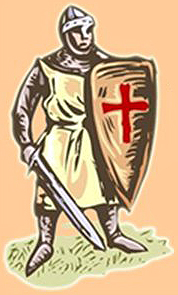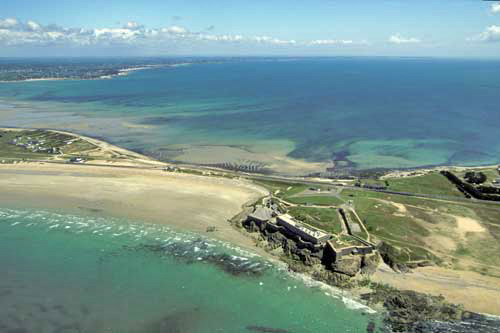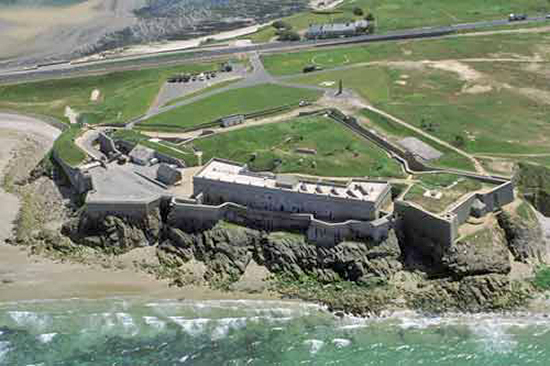|

 Explorers, Scientists &
Inventors
Explorers, Scientists &
Inventors
 Musicians, Painters &
Artists
Musicians, Painters &
Artists
 Poets, Writers &
Philosophers
Poets, Writers &
Philosophers
 Native Americans & The Wild
West
Native Americans & The Wild
West
 First Ladies
First Ladies
 Popes
Popes
 Troublemakers
Troublemakers
 Historians
Historians
 Archaeologists
Archaeologists
 Royal Families
Royal Families
 Tribes & Peoples
Tribes & Peoples

Assassinations in History
Who
got slain, almost slain, when, how,
why, and by whom?
 Go to the
Assassination Archive
Go to the
Assassination Archive




Online History Dictionary A - Z
All-Time Records in
History
What was the
bloodiest battle, the battle with the least
casualties, who was the greatest military leader?
 Go to
Records in History
Go to
Records in History

|
|

Fort Penthièvre
and the Quiberon Bay
Ministère de la Défense
Battle of Quiberon — June 27,
1795
The Battle of Quiberon
in 1795
was part of the
 Wars of the
Vendée, which in turn were part of the Wars of the
Vendée, which in turn were part of the
 French
Revolutionary Wars.
French
Revolutionary Wars.
|
|
Quiberon
is located in Morbihan, Brittany, France.
Here is more about
 Quiberon, including a nice map.
Quiberon, including a nice map.
The Invasion
On June 27, 1795, a British fleet
arrived at Quiberon Bay, disembarking 5,400 French royalist
 émigrés
at Carnac (see map.) émigrés
at Carnac (see map.)
Leader of the invasion force was
Count Joseph de Puisaye. Second
in command was Count D'Hervilly.
The idea was to capture Fort
Penthievre, to defend the Quiberon peninsula, to encourage a general
royalist counterrevolution, and of course to restore the monarchy.
British reinforcement would soon be on
its way.
Around 12,000 royalist rebels from Brittany
came to meet, greet, and join the expedition.
Among them was
Charette de La Contrie, one of the leaders of the
rebels in the Vendee. He had just recently (February 17, 1795)
signed the Treaty of
La Jaunaye (Traité de La Jaunaye), which was a
peace treaty between the republicans and the royalists.
Together, invasion force and rebels in residence stormed Fort Penthièvre, located on the wee stretch of land
that connects Quiberon with the mainland (see map.)
|

QUIBERON BAY
Click map to enlarge
The Days
Following the Invasion
The republican forces arrived at Ste
Barbe and begun digging a trench effectively cutting off the
peninsula. Puisaye thought it would be best to nip this in the bud.
On July 7, just before dawn, Puisaye
and 2,000 men attacked the republicans at Ste Barbe but they had to
withdraw.

Map Location Ste Barbe
Google Map
By the time the royalists had figured
out whether or not Puisaye was the best choice for a leader, more
republican troops, led by
 General Lazare Hoche, had
gathered and were on the move.
General Lazare Hoche, had
gathered and were on the move.
Hoche pushed the main invasion force
back onto the peninsula. Trapped, they either holed up
in Fort Penthievre or went into the sea. Some 900 made it back to
the British boats, Puisaye was among
them.
Republican Victory
On the night of July 20, 1795, the Republicans
attacked Fort Penthièvre. The next morning, on July 21, 1795, the
royalists surrendered.
Hoche had 6,263 royalists arrested and
748 were shot at Brech, just outside Auray, where they were buried.
Today, that site is called Le Champ des Martyrs.

Fort Penthièvre
Ministère de la Défense
Causes of the
Republican Victory
Rivalries among the royalists, caused by confusion about
the legitimacy of the appointment of the persons in charge, led to their
defeat.
Another reason for the failure of the expedition were
the republican soldiers that had been captured by the royalists and
had been "converted" to the royalist cause. In truth, they weren't really won over at
all and helped the republican cause a great deal from the inside of
the enemy's camp.
Quiberon Bay in 1759
Here is more about the
 Battle
of Quiberon Bay in 1759.
Battle
of Quiberon Bay in 1759.
More History
|